Tired of lugging those heavy water bottles to the water coolers or simply want to improve the quality of your drinking water without breaking the bank? Well, an under sink water filter system may be the solution you have been looking for. They are simple and quick to install, economical, provide immediate health benefits and contribute positively to the environment (by reducing plastic bottle disposition).
Water Quality Properties & Parameters
Let’s first review some basic properties and parameters of water. So that we stay focused, the assumption is that “potable” water satisfying your local water quality standards is flowing to your sink. The definition of “potable” water is water that is safe to drink, pleasant to taste and usable for home purposes. Anything less would likely require a central water purifying system which is outside the scope of this discussion.
There are three types of water properties:
- Physical ; includes parameters such as Turbidity (i.e. water clarity), color, taste, solids and electrical conductivity of water.
- Chemical ; includes parameters such as pH, Acidity, Alkalinity, Chloride, Chlorine, Sulfate, Nitrogen, Fluoride, Iron, Copper, Hardness, Toxic Organic and Inorganic substances.
- Biological ; includes parameters related to Bacteria, Algae, Viruses, Protozoa and coliforms.
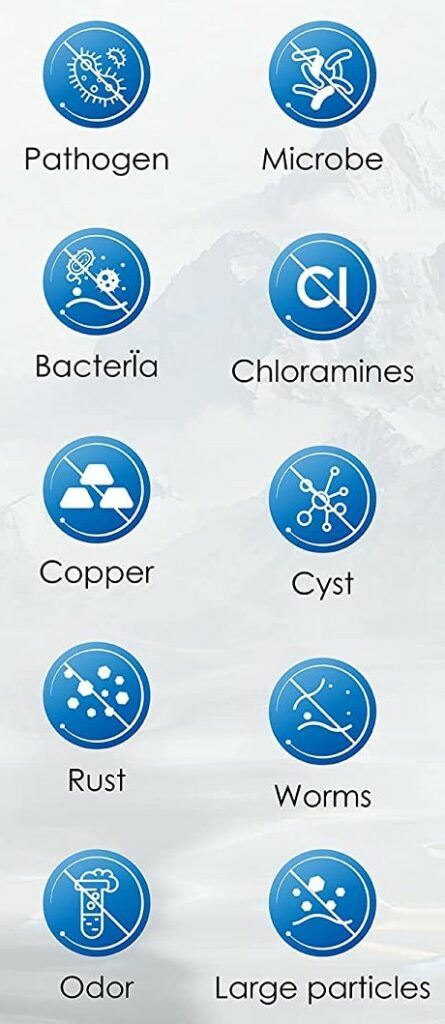
Thankfully, “potable” water includes the filtration of many of the harmful parameters upstream at the local water filtration plant or at the Well-water filtration system. We will remain focused on the handful of potentially harmful and/or causing distasting water parameters that can be further reduced/filtered with an Under Sink Water Filter System. This will allow you to attain or exceed the equivalent of your “bottled water” experience.
Typically, the Product Vendors for Under Sink water Filters will target to reduce the following water parameters also known as water contaminants:
- Chlorine – This is not harmful to your health but carry an unpleasant taste and smell.
- Fluoride – Excessive amounts can cause discoloration of teeth also known as Fluorosis. Small amounts are good for your dental hygiene.
- Lead – This can cause health issues in the smallest amounts.
- Iron – Doesn’t cause health issues but impart a bitterness taste to drinking water.
- Copper – Beneficial for human health and growth of plants but hey can cause undesirable tastes in drinking water.
- Nitrates – Excessive nitrate concentration (more than 10 mg/L) causes an immediate and severe health threat to infants.
- Bacteria – This can affect taste and smell of water and can cause health issues.
- Solids (i.e. Total Dissolved Solids (TDS)) – It is a physical property of water representing the amount of dissolved organic and inorganic compounds that can pass through a 2-micrometer sieve. The concentration is expressed in PPM or mg/L. TDS levels of < 600 mg/L are generally considered to be good for drinking water.
More details on water quality parameters can be found here.
How an Under Sink Water Filter System Works
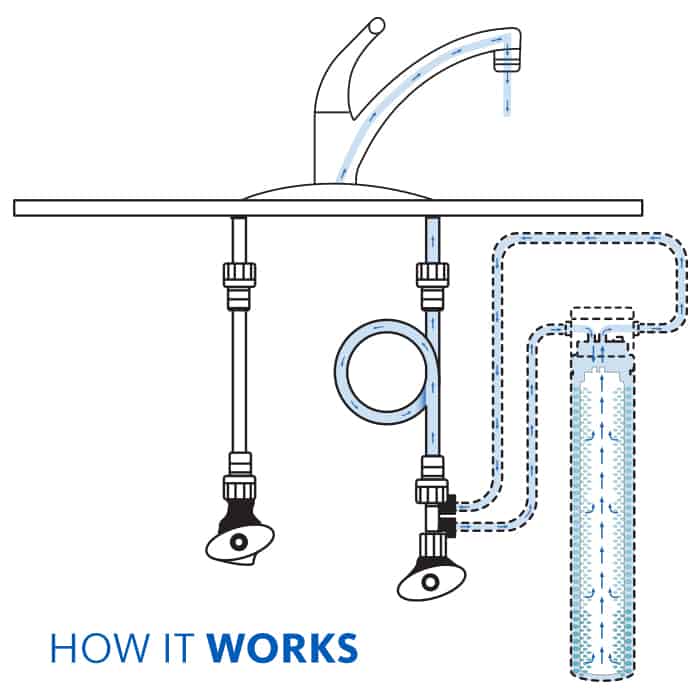
Now that we have grasped the basic understanding of drinking water characteristics, lets talk about how an under sink water filter system works. Simply put, it is a device installed under your kitchen sink, integrated with your cold water supply and equipped with one or more filter assemblies. In some cases, it comes with its own faucet or it can be used with the existing cold water faucet.
Water flows through the single or multistage filter system reducing the contaminants and voila, you have filtered water coming out of your cold water faucet. What determines the effectiveness of the water filtration is dependent on the patented technology behind the filters which is the primary discriminating factor that discerns one product vendor from the other.
Key Characteristics of Systems
There are many Product Vendors providing different configurations and technologies for Under Sink Water Filter System. This makes it difficult to select the product that is best suited for your needs. I will assist you by first describing the options that are available to the Consumer and in the next section, I will provide you with some guidance on how to select products for your specific situation.
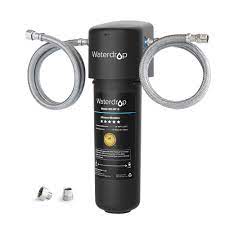
Filter Technologies
Without going into insurmountable detail on filters, I will list the most common type found and what they best suited for:
- GAC (Granular Activated Carbon) Filters; actively reduce water contaminants but unable to remove iron and nitrates since they are not attracted to carbon.
- Coconut Shell Activated Carbon Filters; actively reduce water contaminants but it has more porosity that the GAC filters which translates in absorbing more contaminants.
- Carbon Block Filters; This filter has a larger surface area than the GAC filters allowing it to remove more contaminants.
- CTO (Chlorine Taste Odor) Filters; This filter will produce water which is clearer with a more appealing taste. Like GAC, it uses “activated” carbon in order to increase the surface area and have smaller pores which has consequential effect of slowing down the flow or clogging.
- KDF (Kinetic degradation Fluxion) Filters; This filter uses high purity copper-zinc granules to reduce contaminants in water using the oxidation/reduction reaction. It is very effective in removing copper, iron, lead and other metals from water. This filter technology normally complements the aforementioned carbon-based filters to widen the spectrum of contaminant removal/reduction.
- Ultra-filtration Membrane Technology Filters; This filter uses the latest technology to effectively remove not only the physical and chemical contaminants, but the biological (bacteria, viruses and others) contaminants in water.
- Reverse Osmosis Filters; This filter is normally used as a point of entry system when the water entering the home is not “potable”. This type of filter purifies, not filters water and is likely overkill for an under sink water filter system.
Staging
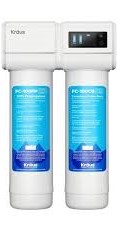
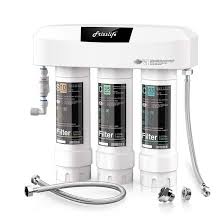
Under Sink Water Filter Systems come with single or multi-stage filtering. Single stage systems have one filter and multi-stage filters have more than one filter. Each filter reduces the contaminants sequentially with the first filtering the largest contaminants (measured in microns) while the last filtering the smallest contaminants. As an example, a three filter system can filter sediment in the first, than use a GAC filter for the second and a Carbon Block filter for the third.
Normally, staging is synonymous with the number of filters but this is not always the case. The Ultrafiltration Membrane technology Filters apply multi-staging in one filter. Though this seems to be an advantage because managing fewer filters, this technology is relatively new and needs more time to prove its value.
Filter Capacity
Filter capacity determines the service life (in months) or gallons of water have to pass through the filter ( in thousands of gallons) before the filter needs to be replaced. This is an important characteristic as it a cost driver for maintenance of the system. You will know when it is time to change the filter since the flow rate will diminish substantially. Other systems have indicator lights to show you when it is time to change the filter.
Installation Complexity
Ease of installation is key for the consumer. The product vendors dwell on the simplicity of the installation claiming that it can be done anywhere from 5 minutes to 30 minutes. All you’ll need to make sure of is that your pipe fittings are compatible with the system; some vendors will provide you with adapters that make it even easier for you.
One other important aspect of the installation is how difficult it is to replace the filter. Most filters are twist and turn types but I have seen some filters that are a little more involved to replace. I would definitely consider the ease of filter install when selecting a system.
What System is Best for You

The short answer is “it depends”. You’ll to understand what is in the “potable” water at your sink. Testing your water will allow you to select the right system for you. There are many inexpensive water test kits (check here) that will enable you to determine what is in your water.
Do you have high levels of Chlorine in you water? A simple single stage GAC filter system may do the trick. Do you have excessive iron or lead in your water? A system with a combo GAC/CTO filter will help. Some bacteria in your water? Use a system with Ultra-filtration Membrane Technology Filter. Do you want to maximize the removal contaminants to near 100%? Then use a multi-filtering system.
Conclusion
There are a variety of Under Sink Water Filter Systems available. I’m hoping that the information provided will allow you to select system compatible to your situation with the ultimate goal of bringing better than “bottled water” quality to your sink.
If you have any questions on the above or would like to share your experience, please let me know in the comments below. I will be more than happy to respond to your questions as best I can.

Very interesting information. Thank you for your invaluable service to the community, Mike!
Thank you for your feedback!
Thank you, Mike. This is a great idea. Question for you – are ‘do-it-yourself’ home water tests (test strips) as accurate as kits that are mailed out to a lab for testing?
Thank you for your comment. The most effective method to test your water is to send a water sample to a Water analysis laboratory. This can be expensive and should only be used if you suspect something visually unappealing, smelly, or distasteful about the water entering your home. Mail-in test kits use the same system as consumer purchased test kits – i.e. for the most part they use the test strip method which uses shades of colors to identify the resulting range for the contaminants; they are for the most part equally accurate. The difference between the two may be the number of contaminants tested for. Still, I can assure you that there are different test kits available, some of which are more “effective” than others from a list of contaminants’ perspective. Having said this, the only advantage I would give the mail-in test kit is you would have access to water analysis experts providing you with feedback on the results. The question you have to ask yourself is if this additional service provided is worth the additional cost of the mail-in test over your “home depot” or “Amazon” procured test.
Thanks, Mike! This is super helpful.